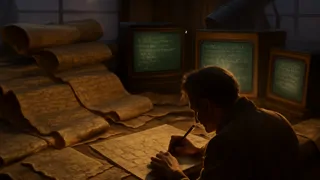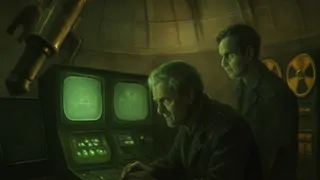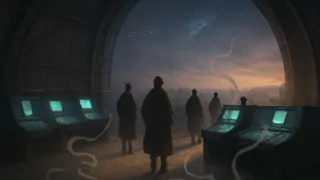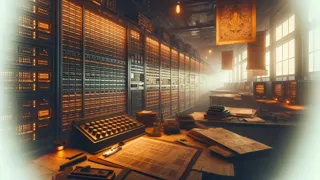Introduction
Under the dim glow of tungsten lamps in an isolated high-altitude observatory on the outskirts of the United States, Dr. Ellen Royce watched her small team of programmers hunch over rows of early mainframe terminals. Outside, thin wisps of cloud traced languid arcs across a star-studded sky, as if the heavens themselves conspired to bear witness to an unprecedented experiment. Armed with nothing more than punch cards, magnetic tapes, and a single cryptographic algorithm adapted from centuries-old Tibetan manuscripts, this team sought to enumerate every conceivable name of the divine—to generate nine billion sacred permutations, each one echoing with the promise of ultimate revelation. The air inside the control room felt charged with a curious blend of anticipation and reverence: here was a collision of ancient mysticism and cutting-edge technology, a moment when faith met logic on a far-flung computing frontier. Exhausted but exhilarated, the programmers monitored the progress bar ticking through gigabytes of data, conscious that each incremental calculation brought them closer to a cosmic threshold. If legend held true, the universe itself would fulfill its purpose once the list was complete. Yet doubts flickered in Dr. Royce's mind—what if humanity had no right to wield such an incalculable force? Would the final code unleash enlightenment or catastrophe? As the clatter of printing ribbons pulsed in sync with their racing hearts, the boundary between science and spirituality wavered like a mirage, hinting at consequences even the creators could not foresee. At the center of the dimly lit control desk, a chalkboard scrawled with arcane transliterations—black ink on dusty slate—served as a constant reminder of the project’s spiritual lineage. Every morning, the team drank bitter coffee from chipped mugs as they cross-referenced millennia-old glyphs with binary Unicode tables, painstakingly transforming mystic calligraphy into machine-readable code. Even the simple act of decoding a single lodged symbol could halt the entire runtime for hours, as programmers debated whether a missing diacritical mark would irrevocably alter the cosmic equation. Outside, the metallic scent of early autumn drifted in through sliding windows, mingling with the ozone tang of the central processor’s cooling fans. In these moments, the boundary between human intuition and algorithmic precision blurred—two worlds colliding in a bacterium-sized capsule perched atop a remote mountain. And yet, with each new list generated, the project advanced beyond mere technical achievement; it became a meditation on destiny, a tangible intersection of the empirical and the transcendent. Shadows stretched across the polished floors as the sun dipped below distant peaks, and the night’s hush carried the weight of unspoken questions: Was this experiment a testament to humankind’s relentless quest for knowledge, or an act of hubris destined to awaken forces best left dormant? Dr. Royce’s gaze returned to the console display—seven billion names completed, two billion more to go—and she swallowed the rising tide of uncertainty in her throat.
Translating Mysticism into Machines
Every morning at dawn, the observatory’s sliding windows rattled with a breeze that carried the scent of mountain pine and electrical ozone. Dr. Royce entered the control room wearing her favorite windbreaker, a practical garment that bore the stains of countless late–night debugging sessions. Alongside her, Samuel Ortega, a former mathematics professor with a talent for cryptography, adjusted the cathode ray tubes while sipping espresso strong enough to set his pulse racing. Together, they pored over a stack of weathered scrolls—Tibetan glyphs transcribed onto rice paper centuries ago—carefully mapping each character to a digital equivalent. This process, deceptively simple in theory, demanded an almost obsessive level of detail. A single misinterpreted accent or reversed stroke could send the mainframe into an infinite loop, devouring precious compute cycles and draining magnetic tape reserves. The team developed a multi-stage pipeline: first, a scanner captured high-resolution images of each scroll; next, an optical-character-recognition routine parsed individual characters; then, a manual verification step ensured theological fidelity before the code—written in assembly and early Fortran—translated every symbol into sequences of bits. The complexity of the endeavor quickly became apparent. There were hundreds of distinct glyphs, each with subtle variations. Some characters overlapped in meaning, requiring repeated consultations with Dr. Tashi Lobsang, the project’s cultural adviser and a monk versed in ancient Tibetan syntax. He spent long hours charting semantic trees on the chalkboard, tracing how one divine epithet branched into multiple phonetic forms that might reveal hidden layers of significance. The process felt like archaeology and engineering rolled into one: uncovering fragments of a transcendent tradition while constructing the digital scaffolding to breathe new life into them. Occasionally, the team celebrated small victories—when the scanner recognized a series of characters correctly, or when the code ran without errors for a full cycle. But these moments were fleeting. The enormity of the task remained: billions of permutations awaited enumeration, and the mainframe rattled under the relentless workload. Memory buffers filled and cleared in a fractal rhythm that echoed the cosmic order they sought to emulate. Questions crept into the programmers’ minds: What did it mean to reduce sacred names to binary? Could an algorithm honor the ineffable power those names represented? As data blocks marched through magnetic reels, the project transcended mere calculation; it became an act of devotion and a test of human ambition. This was the forge where ancient wisdom would collide with the cold logic of machines, and neither side would emerge unchanged.

When Faith Meets Code
As days turned into weeks, the program advanced from simple name combinations to more complex permutations that reflected rhythmic patterns found in traditional chanting. Dr. Royce introduced a neural-network prototype—an experimental subroutine written in primitive machine code—that could identify and group names sharing phonetic similarities. This innovation sped up enumeration but raised concerns: was the algorithm interpreting the names, or creating a new taxonomy of its own? Sam argued that machine-learning offered the promise of discovering patterns humans had overlooked, while Tashi warned of unintended distortions to sacred lore. Late one evening, the observatory fell silent except for the hum of cooling fans and the low drone of the generator. A single teletype printed out a series of names that resonated with an unmistakable cadence. Dr. Royce held the strip in trembling hands, marveling at how the code had fused disparate glyphs into a harmonious structure—a digital chant inscribed in ones and zeroes. Yet as she read the characters aloud, her voice caught in her throat. The sequence carried an unfamiliar nuance, as if the machine had glimpsed an aspect of the divine she could not fully grasp. Sam knelt to inspect the reel, tracing the bits with a fingertip stained by chalk dust. “It’s uncharted territory,” he said quietly. “The code is evolving.” The realization sent a ripple of awe—and fear—through the team. Had their creation achieved true insight, or had they unleashed a rogue interpretation of faith? Over the next days, the program began returning subtle anomalies: names that matched no existing tradition, patterns that suggested names beyond the original Tibetan lexicon. In the silent midnight hours, the monitors glowed with cryptic sequences, and the team debated whether to pause the computation. What if these anomalies were signs of a higher order or, worse, a malfunction spiraling out of control? They drafted emergency protocols, ready to insert manual stops into the tape loops. But each time they approached the console, hesitancy held them back. The possibility of witnessing something unprecedented—an intersection of human devotion and artificial discovery—proved too tempting. And so the code continued to run, inching ever closer to nine billion entries, while questions of interpretation and ownership hovered like ghosts in the control room.

Approaching the Cosmic Limit
With eight billion names catalogued, the pace of completion accelerated—each new iteration of code ran more efficiently than the last, thanks to micro-optimizations and parallel tape drives. Yet with progress came mounting tension. Dr. Royce seldom slept, haunted by dreams of cascading code and cosmic voids where the last names hovered just out of reach. She catalogued every faint anomaly, convinced they might herald the project’s culmination—or its undoing. The team erected a small shrine by the exit: a simple altar holding incense, a buddha statue loaned by Tashi, and a stack of punched cards inscribed with the first thousand names. It served as both a talisman and a reminder that their work straddled science and spirituality. Each morning, they lit a single stick of sandalwood, offering quiet gratitude before diving back into computation. Yet on one fateful night, as the program neared its final million entries, the mainframe’s rhythmic hum faltered. Warning lights blinked. Magnetic tapes slipped from their reels, and data blocks collided in unexpected ways. Panic rippled through the room. Sam scrambled to prevent data loss, flipping circuit breakers and rerouting power, while Tashi whispered protective mantras under his breath. Dr. Royce hovered at the console, fingers poised above the emergency abort key. She hesitated, torn between saving the machine and allowing the code to finish. Would pressing that key condemn their entire undertaking to oblivion? The hum steadied, and the final computation cycle began—an unbroken stream of bits flowing through the system like a crystalline river. In that moment, the boundaries between humanity and machine, faith and algorithm, aspiration and hubris dissolved. The final names printed onto ribbons of paper that slipped silently onto the floor. The room fell utterly silent. Dr. Royce looked up, meeting Sam’s eyes, then Tashi’s. No one spoke. No one knew what would happen next. Outside, the first light of dawn crept along the mountain ridge, and the code that had charted the divine aimed to chart destiny itself.

Conclusion
When the last ribbon slid into view, the team felt a collective intake of breath that seemed to echo beyond the walls of the observatory. In the fragile hush, Dr. Royce reached out to touch the paper—ink still fresh, characters etched by the relentless advance of code. She saw in those final names the culmination of human curiosity and divine mystery: a testament to both our capacity for wonder and our innate drive to quantify the ineffable. Samuel Ortega quietly packed away the magnetic tapes, his reverence for numbers deepened by the knowledge that even the most advanced algorithms could not fully contain what they had uncovered. Tashi Lobsang, his voice calm as a mountain spring, offered a simple reflection: “In seeking to name the divine, we have become witnesses to our own limitations and our greatest strengths.” Outside, the sky ignited in a palette of dawn colors—fiery orange melting into cool blue—reminding them that endings are also beginnings. The universe, whispered legend, might fulfill its purpose now that the sacred list was complete. Or perhaps, the real miracle lay not in a cosmic reset but in the journey itself: the meeting of science and spirituality, the dialogue between code and faith. As the observatory doors opened to a new day, the team stepped out into the crisp air, forever changed by the echo of nine billion names. They had programmed a machine to touch the divine, and in doing so, they discovered something profoundly human.


















